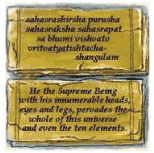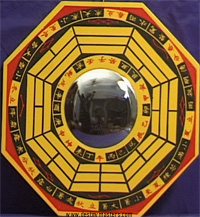|

The term
Upanishad means sitting down near; this implies the
students sitting down near their Guru to learn the big
secret. In the splendid isolation of their forest
abodes, the philosophers who composed the Upanishads
contemplated upon the various mysteries of life and its
creation – whether common, or metaphysical. The
answers were however not open to all, but only for
select students. The reason for this was simple: not
everyone can handle knowledge.
The
composition of the Upanishads marks a significant and
stride forward in the direction of knowing the mystery
of earth's creation and one comes tantalizingly close to
the answers. Through episodes, commentaries, stories,
traditions and dialogue, the Upanishads unfold the
fascinating tale of creation, life, the essence of life
and of that beyond to the seeker of truth.
There is
no exact date for the composition of the Upanishads.
They continued to be composed over a long period, the
core being over 7th -5th centuries BC. The Upanishads
were originally called Vedanta, which literally means
the conclusion to the Vedas.
In the
Upanishads, views about Brahman (the Absolute, or God)
and atman (one's true self) were proposed.
There are
18 principal Upanishads viz:
Brhad-aranyaka
Upanishad
The Brhad-aranyaka Upanishad is widely accepted to be
the most important of all Upanishads. It has three
khandas or parts. The madhu khanda contemplates on the
relationship between the individual and the Universal
self. The muni khanda or yajnavalkya is a debate which
goes on to give the philosophical backing to the earlier
teaching. The khila khanda tackles various rituals of
worship and meditation.
Chandogya
Upanishad
This Upanishad is a part of the Sama-Veda (see The
Vedas). The name comes from the singer of the songs (samans)
who is called Chandoga. The initial chapters of the
Upanishad, discuss the ritual of sacrifice. The others
debate the origin and profundity of the concept of Om,
among other things.
Aitareya Upanishad
This one forms part of the Rig-Veda. The purpose is to
make the reader understand the deeper meaning of
sacrifice and to take him away from the outer trappings
of the actual act.
Taittriya Upanishad
A part of the Yajur-Veda, this Upanishad is divided into
three sections or vallis. The siksa valli deals with the
phonetics of the chants, while the others, brahmananda
valli and bhrgu valli deal with self-realization.
Isa
Upanishad
Also called the Isavasya Upanishad, this book deals with
the union of God, the world, being and becoming. The
stress is on the Absolute in relation with the world (paramesvara).
The gist of the teachings is that a person's worldly and
otherworldly goals need not necessarily be opposed to
each other.
Kena
Upanishad
The name of this Upanishad comes from the first word
kena, or by whom. It has two sections of prose and two
of poetry. The verses deal with the supreme spirit or
the absolute principle (brahmaana) and the prose talks
of ishvara (god). The moral of the story is that the
knowledge of ishvara reveals the way to
self-realization.
Katha Upanishad
Also called the Kathakopanishad, this Upanishad uses a
story (katha) involving a young Brahmin boy called
Nachiketa to reveal the truths of this world and the
other beyond the veil.
Prashna Upanishad
Prashna literally means question, and this book is part
of the Athrava-Veda. It addresses questions pertaining
to the ultimate cause, the power of Om, relation of the
supreme to the constituents of the world.
Mundaka
Upanishad
This book also belongs to the Atharva-Veda. The name is
derived from 'mund' or to shave, meaning that anyone who
understands the Upanishads is s(h)aved from ignorance.
This book inscribes the importance of knowing the
supreme brahmaana, only by which knowledge can one
attain self-realization.
Mandukya
Upanishad
The Mandukya is an exquisite treatise which expounds on
the principle of Om and its metaphysical significance in
various states of being, waking, dream and the dreamless
sleep. The subtlest and most profound of the Upanishads,
it is said that this alone will lead one to the path of
enlightenment.
Svetasvatara
Upanishad
The name of this Upanishad is after its teacher. It
comments on the unity of the souls and the world in one
all-encompassing reality. The concept of there being one
god is also talked about here. It is dedicated to Rudra,
the storm god.
Kausitaki
Brahmana Upanishad
The Upanishad has come down to us in bits here and
pieces there. The core of the text is dedicated to
illustrating the fact that the path to release is
through knowledge.
Maitri
Upanishad
This is a comparatively later Upanishad as it has
references to the Trinity of Hindu Gods (Shiva, Vishnu
and Brahma) which is a later development, and plus
references to the world being illusory in character
reflects Buddhist influence.
Subala
Upanishad
Belonging to the Yajur-Veda, this Upanishad puts down a
dialogue between the sage Subala and Brahma the creator
of the Hindu Trinity of Gods. It discusses the universe
and the absolute.
Jabala Upanishad
Belonging to the Athrava-Veda this Upanishad addresses
some questions pertaining to renunciation.
Paingala Upanishad
The Paingala is again a dialog, this between Yajnavalkya,
the sage mentioned the Brhad-aranyaka's muni khanda and
Paingala, a student of his. It discusses meditation and
its effects.
Kaivalya Upanishad
This Upanishad delves into the state of kaivalya or
being alone.
Vajrasucika Upanishad
Belonging to the Sama-Veda the Vajrasucika reflects on
the nature of the supreme being.
The core of the teachings
of the Upanishads is summed up in three words: tat tvam
as… you are that.
Rameshwar Prasad
invites you to the Wonderful Spiritual World
|

|
CONTACT
THE CONSULTANT
Engineer Rameshwar Prasad (B.Tech., M.Tech., P.G.D.C.A.,
P.G.D.M.) VAASTU INTERNATIONAL
49 C (Second Floor), Pocket- B, SFS
Flats,
Mayur Vihar,
Phase-III,
New Delhi - 110096,
INDIA
TeleFax : +91-11-22615299 (Landline), Mobile : +91-
9810105218
e-mail : vaastuinternational@yahoo.com
vaastuinternational@gmail.com
|

|



